
Minecraft Redstone For Dummies, Portable Edition
Published by John Wiley & Sons, Inc., 111 River Street, Hoboken, NJ 07030-5774, www.wiley.com
Copyright 2015 by John Wiley & Sons, Inc., Hoboken, New Jersey
Published simultaneously in Canada
No part of this publication may be reproduced, stored in a retrieval system or transmitted in any form or by any means, electronic, mechanical, photocopying, recording, scanning or otherwise, except as permitted under Sections 107 or 108 of the 1976 United States Copyright Act, without either the prior written permission of the Publisher. Requests to the Publisher for permission should be addressed to the Permissions Department, John Wiley & Sons, Inc., 111 River Street, Hoboken, NJ 07030, (201) 748-6011, fax (201) 748-6008, or online at http://www.wiley.com/go/permissions .
Trademarks: Wiley, For Dummies, the Dummies Man logo, Dummies.com, Making Everything Easier, and related trade dress are trademarks or registered trademarks of John Wiley & Sons, Inc. and/or its affiliates in the United States and other countries, and may not be used without written permission. Minecraft is a registered trademark of Notch Development. All other trademarks are the property of their respective owners. John Wiley & Sons, Inc. is not associated with any product or vendor mentioned in this book.
LIMIT OF LIABILITY/DISCLAIMER OF WARRANTY : THE PUBLISHER AND THE AUTHOR MAKE NO REPRESENTATIONS OR WARRANTIES WITH RESPECT TO THE ACCURACY OR COMPLETENESS OF THE CONTENTS OF THIS WORK AND SPECIFICALLY DISCLAIM ALL WARRANTIES, INCLUDING WITHOUT LIMITATION WARRANTIES OF FITNESS FOR A PARTICULAR PURPOSE. NO WARRANTY MAY BE CREATED OR EXTENDED BY SALES OR PROMOTIONAL MATERIALS. THE ADVICE AND STRATEGIES CONTAINED HEREIN MAY NOT BE SUITABLE FOR EVERY SITUATION. THIS WORK IS SOLD WITH THE UNDERSTANDING THAT THE PUBLISHER IS NOT ENGAGED IN RENDERING LEGAL, ACCOUNTING, OR OTHER PROFESSIONAL SERVICES. IF PROFESSIONAL ASSISTANCE IS REQUIRED, THE SERVICES OF A COMPETENT PROFESSIONAL PERSON SHOULD BE SOUGHT. NEITHER THE PUBLISHER NOR THE AUTHOR SHALL BE LIABLE FOR DAMAGES ARISING HEREFROM. THE FACT THAT AN ORGANIZATION OR WEBSITE IS REFERRED TO IN THIS WORK AS A CITATION AND/OR A POTENTIAL SOURCE OF FURTHER INFORMATION DOES NOT MEAN THAT THE AUTHOR OR THE PUBLISHER ENDORSES THE INFORMATION THE ORGANIZATION OR WEBSITE MAY PROVIDE OR RECOMMENDATIONS IT MAY MAKE. FURTHER, READERS SHOULD BE AWARE THAT INTERNET WEBSITES LISTED IN THIS WORK MAY HAVE CHANGED OR DISAPPEARED BETWEEN WHEN THIS WORK WAS WRITTEN AND WHEN IT IS READ.
For general information on our other products and services, please contact our Customer Care Department within the U.S. at 877-762-2974, outside the U.S. at 317-572-3993, or fax 317-572-4002. For technical support, please visit www.wiley.com/techsupport .
Wiley publishes in a variety of print and electronic formats and by print-on-demand. Some material included with standard print versions of this book may not be included in e-books or in print-on-demand. If this book refers to media such as a CD or DVD that is not included in the version you purchased, you may download this material at http://booksupport.wiley.com . For more information about Wiley products, visit www.wiley.com .
Library of Congress Control Number: 2014941047
ISBN 978-1-118-96830-7 (pbk); ISBN 978-1-118-96833-8 (ebk); ISBN 978-1-118-96832-1
Manufactured in the United States of America
10 9 8 7 6 5 4 3 2 1
About the Author
Jacob Cordeiro is a senior at the Stanford Online High School, and the writer of Minecraft For Dummies, Portable Edition and Gamestar Mechanic For Dummies. Jacob was a panelist at the ninth annual Games for Change conference, and has a passion for mathematics and game design.
Dedication
To my family and friends. You have all been great navigators, advisors, and peers.
Authors Acknowledgments
Thanks to Amy Fandrei, Kim Darosett, and Becky Whitney, the skilled editors who helped me make each of my books complete.
Thanks to the Nelson family for being excellent friends and technical editors.
Thanks to all of my instructors who taught me the skills that went into this book, including Theodore Alper from Stanford OHS, and Terry Kaufman and Edward Martin from the eIMACS online courses.
Thanks to the vast Minecraft community, which has constantly shown me new and fascinating ideas over the years.
Lastly, thanks to my parents my mother, whose continuous support provided me with the skills and resources to complete this project, and my father, who gave me every possible opportunity to discover my values and potential.
Publishers Acknowledgments
Acquisitions Editor: Amy Fandrei
Senior Project Editor: Kim Darosett
Copy Editor: Becky Whitney
Technical Editor: Ryan W. Nelson
Editorial Assistant: Claire Johnson
Sr. Editorial Assistant: Cherie Case
Project Coordinator: Erin Zeltner
Cover Photo: Cover image courtesy of Jacob Cordeiro
Chapter 1
Introducing Redstone
In This Chapter
 Understanding what redstone is and what you use it for
Understanding what redstone is and what you use it for
 Exploring the essential concepts of redstone
Exploring the essential concepts of redstone
 Understanding the value and applicability of redstone
Understanding the value and applicability of redstone
The world of the game Minecraft is appealing in its infiniteness. In a game where every piece of the world can be destroyed, modified, and rearranged, the possibilities are limitless for how you can work, construct, and venture to make the world your own. This feature is particularly visible in the study of a few choice blocks and items that can function together to form machines of enormous size and scale. The tools, and the science behind these machines, are referred to as redstone.
This chapter introduces you to the basic structure and possibilities of redstone machines.
Exploring Redstone Basics
 Redstone is a dust that you can find underground and use like wiring. Redstone can connect power suppliers (such as levers and buttons) to devices (such as doors and pistons), using the power suppliers to activate the devices from any distance.
Redstone is a dust that you can find underground and use like wiring. Redstone can connect power suppliers (such as levers and buttons) to devices (such as doors and pistons), using the power suppliers to activate the devices from any distance.
You can use redstone to build an automatic door, a light switch, or a trap for the monsters that haunt your Minecraft world. For example, Figure shows how a Minecraft player added a redstone circuit to his house so that he can turn on all the lights on the walls with the flip of a lever. Though these tricks are useful for improving your Minecraft experience, the full extent of redstones possibilities is much more expansive.
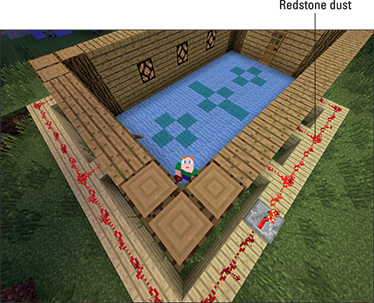
Figure 1-1: Designing a simple redstone light switch.
Redstone technology is often used to build functions machines that convert input (such as flipping a lever or tripping a tripwire) into output (such as activating TNT or moving blocks around). Simply connecting the input to the output with redstone dust is sufficient to design a function. However, you can create more complex functions with the tools I introduce in Chapter . For example, you may want your output to activate only if two buttons are pressed at the same time.

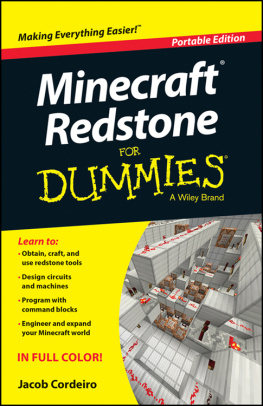
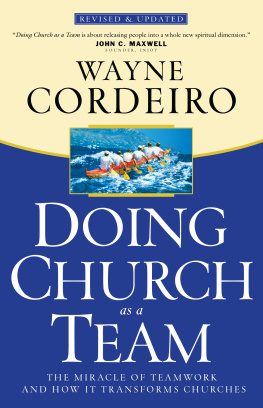

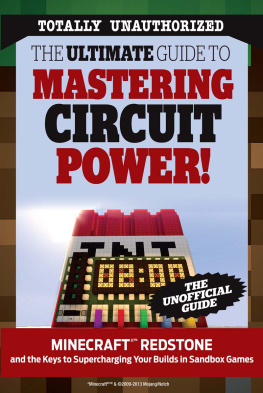


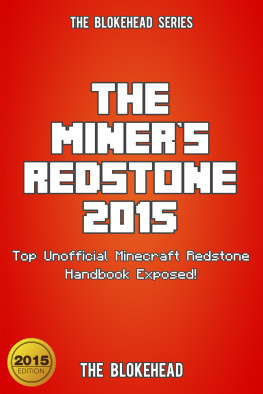
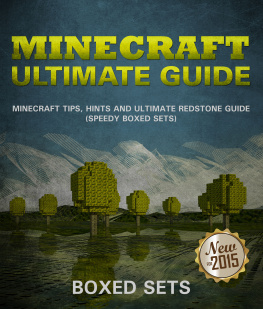
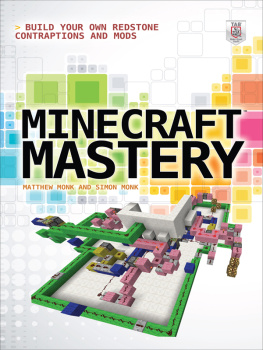
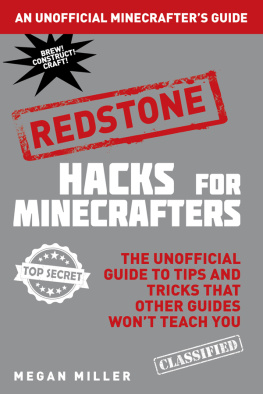

 Understanding what redstone is and what you use it for
Understanding what redstone is and what you use it for Redstone is a dust that you can find underground and use like wiring. Redstone can connect power suppliers (such as levers and buttons) to devices (such as doors and pistons), using the power suppliers to activate the devices from any distance.
Redstone is a dust that you can find underground and use like wiring. Redstone can connect power suppliers (such as levers and buttons) to devices (such as doors and pistons), using the power suppliers to activate the devices from any distance.